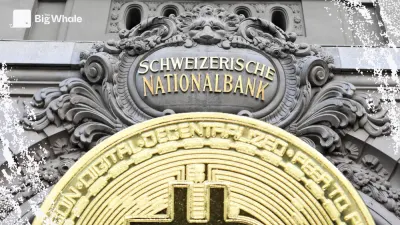TBW - Crypto: The weekend when everything collapsed

It all began quietly on Wednesday, October 9 at 3 p.m. (Paris time). Beijing announced new restrictions on the export of rare earths, those materials essential to the manufacture of semiconductors and green technologies.
From now on, any product containing more than 0.1% rare earths of Chinese origin would need prior government authorization to be exported. The announcement initially went unnoticed, but it quickly inflamed political and financial circles, where it was perceived as a harbinger of a new trade escalation between China and the United States.
The real turning point occurred on Thursday, October 10 around 10:30 p.m. (Paris time). As Bitcoin was retreating modestly from $121,000 to $117,000, significant short (bearish) positions were suddenly opened on the Hyperliquid platform. Thirty minutes later, at 10:57 p.m., Donald Trump announced on his Truth Social network the imposition of 100% tariffs on Chinese imports, in response to Beijing's decision.
In barely twenty minutes, Bitcoin collapsed to $104,000, a drop of 15%. Freshly created accounts that had bet on the decline closed their positions almost instantly, pocketing $192 million in profit. Many observers saw insider trading in this, though it could not be verified.
The shockwave was immediate and unprecedented in scale. Global open interest (the total amount of open positions on derivatives) was cut in half. On Bitcoin, it went from $67 billion to $33 billion, on Ethereum from $38 billion to $19 billion, and on altcoins from $43 billion to $31 billion.
The losses were staggering: some cryptocurrencies like Sui lost up to 80% of their value in five minutes, while the ATOM token collapsed by 99.99% on one exchange.
Within a few hours, more than $19 billion in leveraged positions were liquidated, according to Coinglass data, with nearly 90% on the long side.
Both in percentage and absolute value, the episode surpassed the 2021 flash crash and even the collapse of FTX in 2022.
Excessive leverage among traders
This chaos is explained above all by leverage. In an environment where traders were massively positioned bullish, the slightest correction triggered a cascade of liquidations.
Long positions, unable to maintain their margin, were force-closed, causing a spiral of automatic selling that amplified the drop. Market makers, seeing order book depth evaporate, pulled their orders to protect themselves, further draining liquidity. Funding rates (financing rates between longs and shorts) exploded, forcing even more positions to close. Within a few hours, the mechanics spiraled out of control until collapse.
>> Les techniques des market makers pour manipuler les marchés
The heart of the problem lies in the structure of perpetual contracts, those derivatives without expiration that dominate the crypto market. Their functioning relies on a strict balance between buyers and sellers: every dollar gained on one side is lost on the other. When long positions can no longer be maintained, they are liquidated, and if the liquidation price exceeds the remaining margin, it's the platform's insurance fund that absorbs the loss.
When this fund is no longer sufficient, exchanges activate the auto-deleveraging mechanism (ADL), which forces the closure of certain winning positions to preserve the overall balance (this is the case with Hyperliquid in particular).
This is exactly what happened on Thursday night into Friday, at the height of the panic. Even traders profiting from the decline saw their positions force-closed, because the system could no longer find counterparties.
On Hyperliquid, the HLP vault, which centralizes liquidations and redistributes penalties to liquidity providers, raked in $40 million in profits in one hour.
Other platforms, like Lighter, chose a different approach by absorbing some of the losses themselves, which led to several hours of service interruption. This dilemma (should we protect traders or liquidity providers?) remains at the heart of decentralized platform design.
>> Téléchargez notre briefing sur les produits dérivés crypto
Panic on centralized platforms
Centralized exchanges, for their part, faltered.
Binance, OKX, Bybit and others experienced significant slowdowns at the most critical moment. Some users claim to have been liquidated for lack of being able to place an order. Binance acknowledged temporary malfunctions and announced a compensation program of $283 million.
On the DeFi side, the Aave protocol demonstrated exemplary robustness: $180 million in collateral was automatically liquidated in one hour, with no residual debt, thanks to a hybrid oracle system updated in partnership with Ethena Labs.
The USDe stablecoin, backed by ether via a hedge in perpetual contracts, nevertheless experienced a brutal depeg down to $0.62 on Binance, before regaining its peg thanks to maintaining redemptions at parity on the primary market.
The episode illustrated the vulnerability of oracles: when each platform displays divergent prices, which reference should be used? Aave chose to rely on Ethena's proof of reserves rather than on CEX prices, which could have saved up to $4.5 billion in positions.
Key takeaways
In this storm, a few players emerge stronger.
Aave confirmed its reputation as a model of governance and risk management. Hyperliquid, despite the violence of the shock, held up without major outage and consolidated its image as robust infrastructure. Ethena, for its part, validated the solidity of its model by surviving an extreme crisis.
But behind these successes, the list of losers is long. Centralized exchanges are criticized for their technical failures, market makers for having deserted at the height of the panic, and retail traders for having been crushed by a system they don't master.
In total, 1.6 million accounts were liquidated, an absolute record, and the size of the derivatives market was cut in half in a few hours.
This black weekend illustrates the new nature of the crypto market, now fully integrated into global economic dynamics. In a few tweets, the American president triggered a financial storm of planetary scale, reminding us that crypto no longer lives in a vacuum. Ironically, Donald Trump, who has become one of the main political promoters of the sector since his return to the White House, will have caused the worst day in its history.
Beyond the immediate shock, the episode marks a turning point: the crypto market, which aspired to autonomy and resilience, discovers itself vulnerable to the whims of geopolitics. To hope to become a pillar of global finance, it will now have to prove that it can withstand not only speculation, but also politics.
>> Briefing - L'état du marché crypto au 3ème trimestre 2025



